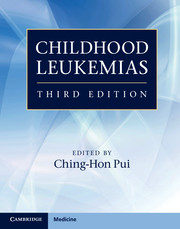Book contents
- Frontmatter
- Contents
- List of contributors
- Preface
- Section 1 History and general issues
- Section 2 Cell biology and pathobiology
- 4 Immunophenotyping
- 5 Immunoglobulin and T-cell receptor gene rearrangements
- 6 Cytogenetics of acute leukemias
- 7 Molecular genetics of acute lymphoblastic leukemia
- 8 Molecular genetics of acute myeloid leukemia
- 9 Epigenetics of leukemia
- 10 Genetics and cellular drug resistance in acute leukemia
- 11 Heritable predisposition to childhood hematologic malignancies
- Section 3 Evaluation and treatment
- Section 4 Complications and supportive care
- Index
- Plate Section
- References
4 - Immunophenotyping
from Section 2 - Cell biology and pathobiology
Published online by Cambridge University Press: 05 April 2013
- Frontmatter
- Contents
- List of contributors
- Preface
- Section 1 History and general issues
- Section 2 Cell biology and pathobiology
- 4 Immunophenotyping
- 5 Immunoglobulin and T-cell receptor gene rearrangements
- 6 Cytogenetics of acute leukemias
- 7 Molecular genetics of acute lymphoblastic leukemia
- 8 Molecular genetics of acute myeloid leukemia
- 9 Epigenetics of leukemia
- 10 Genetics and cellular drug resistance in acute leukemia
- 11 Heritable predisposition to childhood hematologic malignancies
- Section 3 Evaluation and treatment
- Section 4 Complications and supportive care
- Index
- Plate Section
- References
Summary
Introduction
The diagnosis and treatment of childhood leukemia rest on the recognition of a leukemic cell population and its cell lineage and, sometimes the stage of maturation. The presence of myeloperoxidase (MPO), Auer rods, or monocyte-associated esterases in leukemic blasts readily identifies most cases of acute myeloid leukemia (AML). By contrast, the leukemic blasts of acute lymphoblastic leukemia (ALL) do not present with unique morphologic or cytochemical features. Malignant megakaryo-blasts also lack definitive cytologic and cytochemical features and may be mistaken for ALL. Although rare in children, chronic lymphoid malignancies, such as human T-cell lymphotropic virus type 1 (HTLV-1) leukemia/lymphoma or hepatosplenic T-cell lymphoma, can be confused with reactive lymphocytosis or acute leukemia. Non-lymphoid neoplasms, such as blastic plasmacytoid dendritic cell neoplasm (BPDCN), can mimic acute leukemia in their presentation and morphologic features. The prognosis and therapy for ALL and AML differ greatly; therefore, it is crucial to differentiate between these two acute neoplastic processes. In the absence of diagnostic morphologic features, accurate diagnosis requires contemporary immunologic, cytogenetic, and molecular analyses. Immunologic testing, or immunophenotyping, is an essential component of the diagnostic workup that confirms or establishes the lineage of the leukemia, its stage of differentiation, and, sometimes, its clonality. In addition, the immunophenotype profile of ALL and AML often correlates with non-random genetic abnormalities, facilitates minimal residual disease studies, and provides prognostic information. In the following discussions, the terminology of the 2008 WHO Classification of Tumours of Haematopoietic and Lymphoid Tissues is used, but that of the older classification, the French–American–British (FAB) terminology, is also invoked as needed for simplicity and clarification.
- Type
- Chapter
- Information
- Childhood Leukemias , pp. 72 - 112Publisher: Cambridge University PressPrint publication year: 2012
References
- 1
- Cited by



